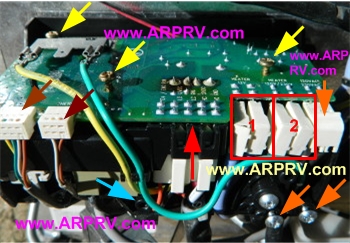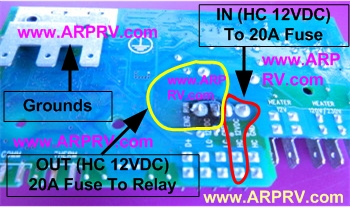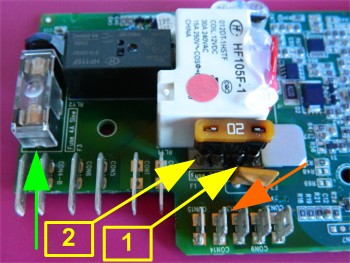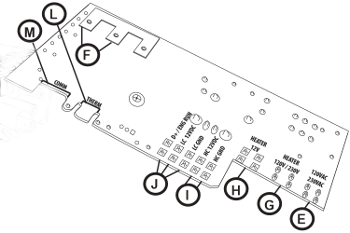If your Norcold 3104 or 3150 will not cool while driving, or the 12 volt heater will not work, here is the control board fix.
The first step once one determines that the 12 volt heater is not working
is to check and see if there is voltage at the terminals identified
as #1 in the photo below. To do this, disconnect the 120VAC power to the control board
at the outlet supplying the fridge. Then remove the single screw that is in the control cover
and slide it off to see the circuit seen in the photo below.
If there is voltage going to the heater, check the resistance of the heater element with an ohm
meter. For the heater resistance click here for
Norcold N3104 & N3150 Specification Table.
If there is not voltage going to the heater, either the fuse is blown or the circuit board
has overheated due to high resistance in the 12 volt heater circuit. Proceed to the next section
to remove the circuit board for inspection.
Click here for an additional wiring diagram that is a printable PDF

Begin by removing the wires from the circuit board. At the upper left of the photo are 2 ground wires, below are two push on connectors (brown arrows) for the circuit board. Next are the 12 volt heater wires mentioned above above (#1), and the 120VAC heater wires (#2), please check the resistance of this heater. The orange arrow points to the 120VAC supply wire, remove the two screws (orange arrows) that hold the 120VAC wire strain relief. Now pull the 120VAC terminals off of the circuit board.
There are 3 screws securing the circuit board, the yellow arrows point to these screws. Once these screws are removed, the wires seen at the red arrow hold the circuit in place. Gently, insert a slot screwdriver between the circuit board and the wire connectors and twist to push the circuit board off of the connectors.
Simply reverse the order of operations to reinstall the circuit board.

This is the top side of the circuit board, starting from the right, the red line encloses the supply traces for the high current 12 volt (HC 12VDC) power to the circuit board. At the bottom of the red line is the spade connector that brings the power in from the RV power supply, take note to this because this wire will be removed from the circuit board and wired directly to an in-line fuse.
At the top of the red line is the two solder connectors for the fuse seen in the photo below identified as yellow arrow #2.
The yellow line encloses the fused side of the HC 12VDC to the relay on the circuit board, the relay is the white component seen just above the fuse in the photo below. At the bottom side of the yellow lined enclosure is where the high resistance occurs that results in the failure of the 12 volt heater. This is evidenced by the black overheated circuit board. At the top of the yellow line enclosure are the leads that supply the relay with power.

In order to repair this issue, remove the 20 amp fuse and the wire that connects to the lead where the orange arrow points. Get an in-line fuse holder capable of handling 30 amps, and with long enough leads that the fuse can be routed outside the circuit board cover for ease of access. Connect the HC 12VDC wire removed in the last step to one end of the fuse holder. Connect the other end of the fuse holder to the circuit board in the location where the yellow #1 arrow points. This connection can be made by one of two methods:
1) Put a male-spade connector on the fuse holder wire and plug it into the circuit board fuse holder where the #1 yellow arrow terminates. Caution, make sure the solder joint is re-soldered at the circuit board fuse holder. Overheating of this joint will oxidize the solder, oxidization results in high resistance, thus this connection requires re-soldering to repair the bad connection. For this reason we prefer the second approach below, this takes more time but should give dependable results.
2) This second method takes a little more work, but should give good results. Use the soldering iron to remove the circuit board fuse holder terminal at the end of the #1 arrow. Clean up the holes in the circuit board with some solder wick and some flux. Insert the largest wires that will fit into each of the holes in the circuit board, solder these wires onto the board, connect the other end of these wires to the in-line fuse.

(E) 120VAC Power Cord from RV Shore-Power
(F) Ground Connector (GND)
(G) 120VAC Heater Element
(H) 12VDC Heater Element
(I) 12VDC High Current (HC) Supply for 12V Heater Element
(J)
3-terminals starting at left:
H+: Signal From Engine to activate the 12VDC heating element.
Remove this wire to prevent 12 volt heater from activating when engine starts.
LC 12VDC:
This is the LC (low current) 12VDC supply wire for the controller.
This is the wire that the ARP yellow wire is ultimately connected to.
LC GND:
This is the LC (low current) 12VDC Ground (GND) for the controller.
(L)
Refrigerator temperature sensor (thermistor) for regulation of fridge cabinet temperature.
Click here for thermistor values
(M) Communications (COM) with front control panel.